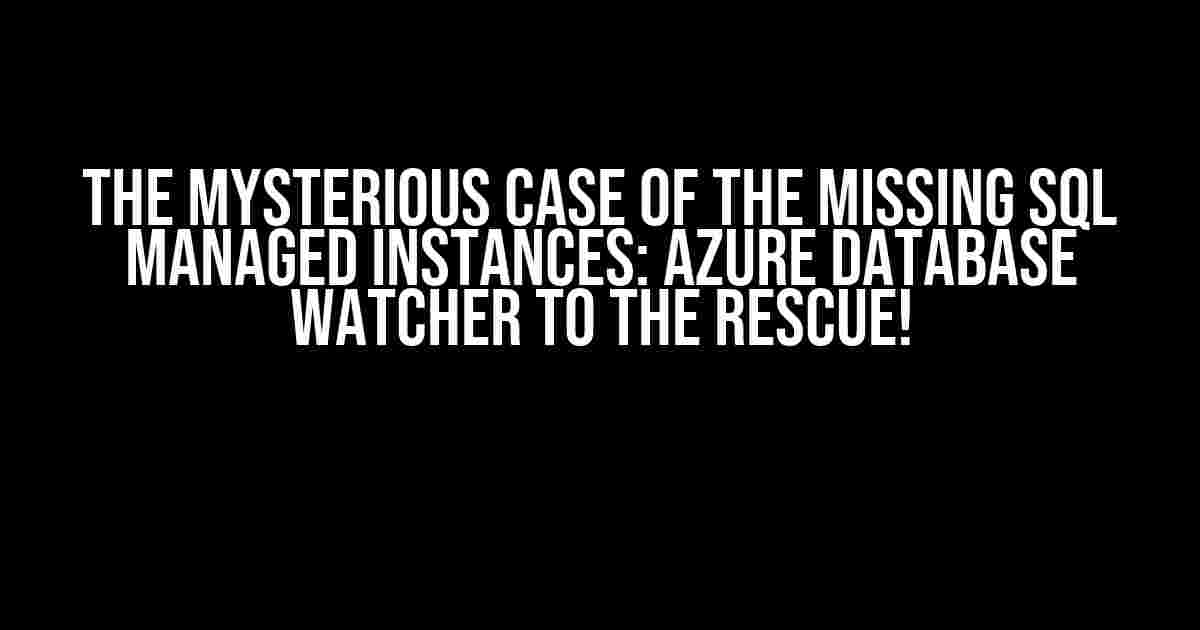Have you ever felt like a detective trying to crack a puzzling case? You’re not alone! Many Azure users have stumbled upon the enigmatic issue of Azure Database Watcher connected to SQL Managed Instance failing to display any SQL Managed Instances in the dashboard. It’s as if the instances have vanished into thin air!
The Plot Thickens: Understanding the Azure Database Watcher
Azure Database Watcher is a powerful tool designed to monitor and optimize the performance of your Azure databases. It provides real-time insights, identifies bottlenecks, and offers expert recommendations to improve database efficiency. But what happens when this trusty sidekick fails to display the very instances it’s meant to watch?
The Suspects: Common Causes of the Issue
Before we dive into the solution, let’s examine the potential culprits behind this mysterious behavior:
- Incorrect Azure Subscription or Resource Group: Ensure you’re using the correct Azure subscription and resource group for your SQL Managed Instance.
- Insufficient Permissions: Verify that your Azure Database Watcher has the necessary permissions to access and monitor the SQL Managed Instance.
- SQL Managed Instance Not Registered: Double-check that your SQL Managed Instance is registered with the Azure Database Watcher.
- Azure Database Watcher Configuration Issues: Review your Azure Database Watcher configuration to ensure it’s set up correctly.
The Investigation Begins: Troubleshooting Steps
Now that we’ve identified the potential suspects, it’s time to follow the clues and solve the mystery!
Step 1: Verify Azure Subscription and Resource Group
az account show --subscription <subscription_id>
az resource list --resource-group <resource_group_name>Use the above Azure CLI commands to confirm you’re using the correct subscription and resource group for your SQL Managed Instance.
Step 2: Check Permissions
az role assignment list --scope /subscriptions/<subscription_id>/resourceGroups/<resource_group_name>/providers/Microsoft.Sql/managedInstances/<sql_managed_instance_name>Run the above command to verify that your Azure Database Watcher has the necessary permissions to access and monitor the SQL Managed Instance.
Step 3: Register SQL Managed Instance with Azure Database Watcher
az sql mi-arc watcher configure --managed-instance <sql_managed_instance_name>
--watcher-name <azure_database_watcher_name>
--resource-group <resource_group_name>Use the above command to register your SQL Managed Instance with the Azure Database Watcher.
Step 4: Review Azure Database Watcher Configuration
Log in to the Azure portal and navigate to your Azure Database Watcher dashboard. Ensure that the configuration is set up correctly, and the SQL Managed Instance is listed under the “Monitored Resources” section.
The Breakthrough: Solving the Mystery
By following the troubleshooting steps above, you should be able to identify and resolve the issue preventing the Azure Database Watcher from displaying your SQL Managed Instances.
Common Solutions:
Based on user feedback and Microsoft documentation, the following solutions have helped resolve the issue:
- Checking the Azure Database Watcher configuration and ensuring it’s set up correctly.
- Verifying permissions and granting the necessary access to the Azure Database Watcher.
- Registering the SQL Managed Instance with the Azure Database Watcher using the Azure CLI command.
The Conclusion: Azure Database Watcher Connected to SQL Managed Instance
Congratulations, detective! You’ve cracked the case of the missing SQL Managed Instances! With your Azure Database Watcher now connected to your SQL Managed Instance, you can rest assured that your databases are being monitored and optimized for peak performance.
| Benefits of Azure Database Watcher |
|---|
| Real-time performance monitoring |
| Expert recommendations for optimization |
| Advanced threat detection and security |
| Simplified database management and troubleshooting |
By following the instructions outlined in this article, you’ve not only resolved the mystery of the missing SQL Managed Instances but also unlocked the full potential of the Azure Database Watcher.
The Final Verdict: A Call to Action
Don’t let the mystery of the missing SQL Managed Instances haunt you! Take the first step in optimizing your Azure databases today. Configure your Azure Database Watcher, and unlock the secrets to peak performance and bulletproof security.
Stay vigilant, detectives! With Azure Database Watcher on the case, your databases will be safer, faster, and more efficient than ever before.
- Get started with Azure Database Watcher
- Register your SQL Managed Instance with Azure Database Watcher
- Explore Azure Database Watcher pricing
Happy sleuthing, and remember to keep your databases watchful and secure!
Frequently Asked Question
Get ready to troubleshoot like a pro! Are you stuck with Azure Database Watcher not showing any SQL Managed Instances in the dashboard? We’ve got you covered! Here are the top 5 FAQs to help you resolve this issue.
Q1: Is Azure Database Watcher correctly configured with the SQL Managed Instance?
Double-check your Azure Database Watcher configuration to ensure it’s properly linked to your SQL Managed Instance. Verify that the instance is registered with Azure Database Watcher and that the correct resource ID and credentials are used.
Q2: Are the necessary permissions and roles assigned to the Azure Database Watcher?
Ensure the Azure Database Watcher has the required permissions and roles to access and monitor your SQL Managed Instance. Check if the Azure Database Watcher service principal has the SQL Managed Instance Contributor or higher role assigned.
Q3: Is the SQL Managed Instance running and healthy?
Verify that your SQL Managed Instance is up and running, and that there are no ongoing maintenance or issues that could be preventing Azure Database Watcher from connecting. Check the instance’s status in the Azure portal or using the Azure CLI.
Q4: Have you checked the Azure Database Watcher logs for any errors or warnings?
Investigate the Azure Database Watcher logs to identify any errors or warnings that might indicate the root cause of the issue. Check the logs for authentication failures, connection issues, or other errors that could be preventing the dashboard from displaying your SQL Managed Instance.
Q5: Have you tried restarting the Azure Database Watcher or re-registering the SQL Managed Instance?
Try restarting the Azure Database Watcher service or re-registering the SQL Managed Instance to see if it resolves the issue. This can sometimes refresh the connection and allow the dashboard to display the instance correctly.



